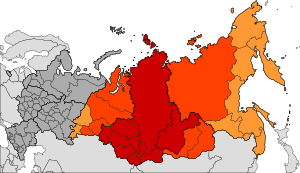East Siberia
| Siberia | |
| Russian: Сибирь (Sibir) | |
| Geographical region | |
| Country | Russia |
|---|---|
| Region | North Asia |
| Borders on | West: Ural Mountains North: Arctic Ocean East: Pacific Ocean South: Kazakhstan, Mongolia, PRC |
| Parts | West Siberian Plain Central Siberian Plateau others... |
| Highest point | Klyuchevskaya Sopka |
| - elevation | 4,649 m (15,253 ft) |
| Area | 13,100,000 km2 (5,057,938 sq mi) |
| Population | 40,000,000 (2010) |
| Density | 3/km2 (8/sq mi) |
Coordinates: 60°0′N 105°0′E / 60.000°N 105.000°E
Geographic Russian Siberia
Siberia (/saɪˈbɪəriə/; Russian: Сиби́рь, tr. Sibir'; IPA: [sʲɪˈbʲirʲ]) is an extensive geographical region, and by the broadest definition is also known as North Asia. Siberia has historically been a part of Russia since the 17th century.
The territory of Siberia extends eastwards from the Ural Mountains to the watershed between the Pacific and Arctic drainage basins. It stretches southwards from the Arctic Ocean to the hills of north-central Kazakhstan and to the national borders of Mongolia and China. With an area of 13.1 million square kilometres (5,100,000 sq mi), Siberia accounts for 77% of Russia's land area, but it is home to just 40 million people – 27% of the country's population. This is equivalent to an average population density of about 3 inhabitants per square kilometre (7.8/sq mi) (approximately equal to that of Australia), making Siberia one of the most sparsely populated regions on Earth. If it were a country by itself, it would still be the largest country in area, but in population it would be the world's 35th largest and Asia's 14th largest.
...
Wikipedia

